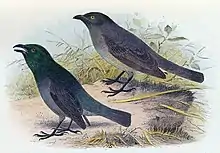Tasman starling
The Tasman starling (Aplonis fusca) was described in 1836 by John Gould as a species which occurred on both Norfolk Island and Lord Howe Island. In 1928 Australian ornithologist Gregory Mathews recognized that the plumage of the race from Lord Howe Island was much browner and more greyish than the plumage of the Norfolk Island race and split the species into two forms, the Norfolk starling (Aplonis fusca fusca), and the Lord Howe starling (Aplonis fusca hulliana). Both subspecies are now extinct, thus so the species.
| Tasman starling | |
|---|---|
 | |
| Scientific classification | |
| Kingdom: | Animalia |
| Phylum: | Chordata |
| Class: | Aves |
| Order: | Passeriformes |
| Family: | Sturnidae |
| Genus: | Aplonis |
| Species: | †A. fusca |
| Binomial name | |
| †Aplonis fusca (Gould, 1836) | |
| Synonyms | |
| |
References
- BirdLife International (2016). "Aplonis fusca". IUCN Red List of Threatened Species. 2016: e.T22710511A94249210. Retrieved 4 December 2020.
- Errol Fuller (2000). "Extinct Birds", ISBN 0-8160-1833-2
External links
- BirdLife Species Factsheet: Norfolk Starling
- Norfolk Island Starling. Aplonis fusca. by Paul Martinson. Artwork produced for the book Extinct Birds of New Zealand, by Alan Tennyson, Te Papa Press, Wellington, 2006
- Illustration on a stamp Birdtheme.org
This article is issued from Wikipedia. The text is licensed under Creative Commons - Attribution - Sharealike. Additional terms may apply for the media files.
